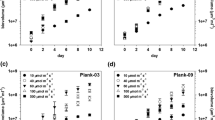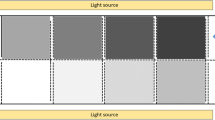Abstract
The occurrence of obligately and facultatively psychrophilic bacteria in the marine environment suggests that environmental conditions exist which can favour each of these groups in competitive processes. Differences were found in the way in which temperature affected the growth rates of obligate and facultative psychrophiles. Maximum specific growth rates of a number of obligately and facultatively psychrophilic bacteria were determined in batch culture and competition experiments were carried out in a chemostat at growth-limiting substrate concentrations. From the results the relation between the specific growth rate and the concentration of the growth-limiting substrate for both types of organisms at different temperatures was deduced. Both at low and high substrate concentrations obligate psychrophiles grew faster than facultative psychrophiles at the lower temperature extreme (⩽ 4 C). These results suggest that obligately psychrophilic chemoorganotrophs are responsible for mineralization processes in cold natural environments such as ocean waters and the arctic and antarctic regions. In these environments they can successfully compete with facultative psychrophiles because they can grow faster.
Similar content being viewed by others
References
Allen, M. B. 1953. The thermophilic aerobic sporeforming bacteria. - Bacteriol. Rev.17:125–173.
Baig, I. A., andHopton, J. W. 1969. Psychrophilic properties and the temperature characteristic of growth of bacteria. - J. Bacteriol.100:552–553.
Duursma, E. K. 1960. Dissolved organic carbon, nitrogen and phosphorus in the sea. - Ph. D. dissertation. Free University, Amsterdam.
Farrell, J. andRose, A. H. 1967. Temperature effects on micro-organisms. p.147–218.In A. H. Rose, (Ed.), Thermobiology,-Academic Press, London.
Hanus, F. J. andMorita, R. Y. 1968. Significance of the temperature characteristic of growth. - J. Bacteriol.95:736–737.
Harder, W. 1969. Obligaat psychrofiele mariene bacteriën.-Ph. D. Thesis, Groningen.
Harder, W. andVeldkamp, H. 1966. Observations on marine obligately psychrophilic bacteria, p.350.In 9th Int. Congr. Microbiol., Abstr. Moscow.
Harder, W. andVeldkamp, H. 1967. A continuous culture study of an obligately psychrophilicPseudomonas species. - Arch. Mikrobiol.59:123–130.
Harder, W. andVeldkamp, H. 1968. Physiology of an obligately psychrophilic marinePseudomonas species. - J. Appl. Bacteriol.31:12–23.
Ingraham, J. L. 1962. Temperature relationships, p.265–296.In I. C. Gunsalus and R. Y. Stanier, (Eds)., The Bacteria, Vol.IV. Academic Press, New York.
Ingraham, J. L. andStokes, J. L. 1959. Psychrophilic bacteria. - Bacteriol. Rev.23:97–108.
Jannasch, H. W. 1965. Continuous culture in microbial ecology. - Lab. Pract.14:1162–1167.
Jannasch, H. W. 1967. Enrichments of aquatic bacteria in continuous culture. - Arch. Mikrobiol.59:165–173.
Monod, J. 1942. Recherches sur la croissance des cultures bactériennes. - Hermann & Cie, Paris.
Morita, R. Y. 1966. Marine psychrophilic bacteria. - Oceanogr. Mar. Biol. Ann. Rev.4:105–121.
Pfennig, N. andJannasch, H. W. 1962. Biologische Grundfragen bei der homokontinuierlichen Kultur von Mikroorganismen. - Ergeb. Biol.25:93–135.
Riley, G. A. 1963. Organic aggregates in seawater and the dynamics of their formation and utilization. - Limnol. Oceanogr.8:372–381.
Shaw, M. K. 1967. Effect of abrupt temperature shift on the growth of mesophilic and psychrophilic yeasts. - J. Bacteriol.93:1332–1336.
Sieburth, J. McN. 1967. Seasonal selection of estuarine bacteria by water temperature. - J. Exp. Mar. Biol. Ecol.1:98–121.
Stanley, S. O. andRose, A. H. 1967. Bacteria and yeasts from lakes on Deception Island. - Phil. Trans. Roy. Soc. London, Ser. B252:199.
Stokes, J. L. 1963. General biology and nomenclature of psychrophilic micro-organisms, p.187–192.In N. E. Gibbons, (Ed.), Recent progress in microbiology VIII. University of Toronto Press, Toronto.
Tempest, D. W. 1970. The continuous cultivation of micro-organisms, p.259–276.In J. R. Norris and D. W. Ribbons, (Eds.), Methods in microbiology, Vol.2. - Academic Press, London.
Author information
Authors and Affiliations
Additional information
We are indebted to Mrs. I. van der Werff-Staverman for skilled technical assistance and to Dr. I. J. Higgins for help in correcting the English manuscript.
Rights and permissions
About this article
Cite this article
Harder, W., Veldkamp, H. Competition of marine psychrophilic bacteria at low temperatures. Antonie van Leeuwenhoek 37, 51–63 (1971). https://doi.org/10.1007/BF02218466
Received:
Issue Date:
DOI: https://doi.org/10.1007/BF02218466




